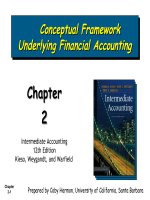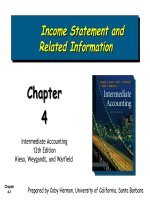Intermediate accounting 12th edition kieso warfield chapter 01
Bạn đang xem bản rút gọn của tài liệu. Xem và tải ngay bản đầy đủ của tài liệu tại đây (306.58 KB, 31 trang )
Financial
Financial Accounting
Accounting and
and
Accounting
Accounting Standards
Standards
Chapter
1
Intermediate Accounting,
12th Edition
Kieso, Weygandt, and Warfield
Chapter
1-1
Prepared by Coby Harmon, University of California, Santa Barbara
Chapter
Chapter 11 Learning
Learning Objectives
Objectives
1.
Identify the major financial statements and other means of
financial reporting.
2.
Explain how accounting assists in the efficient use of scarce
resources.
3.
Describe some of the challenges facing accounting.
4.
List the objectives of financial reporting.
5.
Explain the need for accounting standards.
6.
Identify the major policy-setting bodies and their role in the
standard-setting process.
7.
Explain the meaning of generally accepted accounting principles.
8.
Describe the impact of user groups on the standard-setting
process.
9.
Understand issues related to ethics and financial accounting.
Chapter
1-2
Financial
Financial Accounting
Accounting and
and Accounting
Accounting Standards
Standards
Financial
FinancialStatements
Statements
and
andFinancial
Financial
Reporting
Reporting
Accounting and
Capital Allocation
Challenges
Objectives
The Need to
Develop Standards
Chapter
1-3
Parties
PartiesInvolved
Involvedinin
Standard
StandardSetting
Setting
Securities and
Exchange
Commission (SEC)
American Institute of
Certified Public
Accountants (AICPA)
Financial Accounting
Standards Board
(FASB)
Governmental
Accounting
Standards Board
(GASB)
Changing Role of the
AICPA
Generally
GenerallyAccepted
Accepted
Accounting
Accounting
Principles
Principles
Issues
IssuesininFinancial
Financial
Reporting
Reporting
Political Environment
The Expectations
Gap
International
Accounting
Standards
Ethics
Characteristics
Characteristics of
of Accounting
Accounting
Essential characteristics of accounting are:
(1) the identification, measurement, and
communication of financial information about
(2) economic entities to
(3) interested parties.
parties
Chapter
1-4
LO 1 Identify the major financial statements and other means of financial reporting ..
Characteristics
Characteristics of
of Accounting
Accounting
Economic Entity
Financial Statements
Additional Information
Financial
Information
Balance Sheet
President’s letter
Income Statement
Prospectuses,
Statement of Cash
Flows
SEC Reporting
Accounting?
Identifies
and
Measures
and
Communicates
Statement of
Owners’ or
Stockholders’ Equity
Note Disclosures
GAAP
Chapter
1-5
News releases
Forecasts
Environmental
Reports
Etc.
Not GAAP
LO 1 Identify the major financial statements and other means of financial reporting ..
Characteristics
Characteristics of
of Accounting
Accounting
Review
What is the purpose of information presented in
notes to the financial statements?
a. To provide disclosure required by generally
accepted accounting principles.
b. To correct improper presentation in the financial
statements.
c. To provide recognition of amounts not included in
the totals of the financial statements.
d. To present management’s responses to auditor
comments.
Chapter
1-6
LO 1 Identify the major financial statements and other means of financial reporting ..
Accounting
Accounting and
and Capital
Capital Allocation
Allocation
Resources are limited. Efficient use of resources often
determines whether a business thrives.
Illustration 1-1 Capital
Allocation Process
Financial
Financial
Reporting
Reporting
Information to help
users with capital
allocation decisions.
Chapter
1-7
Users
Users
Investors, creditors,
and other users
Capital
CapitalAllocation
Allocation
The process of
determining how and
at what cost money
is allocated among
competing interests.
LO 2 Explain how accounting assists in the efficient use of scare resources.
Accounting
Accounting and
and Capital
Capital Allocation
Allocation
Review
An effective process of capital allocation is critical to a
healthy economy, which
a. promotes productivity.
b. encourages innovation.
c. provides an efficient and liquid market for buying
and selling securities.
d. All of the above.
Chapter
1-8
LO 2 Explain how accounting assists in the efficient use of scare resources.
Challenges
Challenges Facing
Facing Financial
Financial Accounting
Accounting
Non-financial Measurements
Forward-looking Information
Soft Assets
Timeliness
Chapter
1-9
LO 3 Describe some of the challenges facing accounting.
Objectives
Objectives of
of Financial
Financial Accounting
Accounting
Financial
Financial reporting
reportingshould
shouldprovide
provideinformation:
information:
(a)
(a) that
thatisisuseful
usefulto
topresent
presentand
andpotential
potentialinvestors
investorsand
and
creditors
creditorsand
andother
otherusers
usersin
inmaking
makingrational
rationalinvestment,
investment,
credit,
credit,and
andsimilar
similardecisions.
decisions.
(b)
(b) to
tohelp
help present
presentand
andpotential
potential investors
investorsand
andcreditors
creditorsand
and
other
otherusers
usersin
inassessing
assessingthe
theamounts,
amounts,timing,
timing,and
and
uncertainty
uncertaintyof
ofprospective
prospectivecash
cashreceipts.
receipts.
(c)
(c) about
aboutthe
theeconomic
economicresources
resourcesof
ofan
anenterprise,
enterprise, the
theclaims
claims
to
tothose
thoseresources,
resources,and
andthe
theeffects
effectsof
oftransactions,
transactions,
events,
events,and
andcircumstances
circumstancesthat
thatchange
changeits
itsresources
resourcesand
and
claims
claimsto
tothose
thoseresources.
resources.
Chapter
1-10
LO 4 List the objectives of financial reporting.
Objectives
Objectives of
of Financial
Financial Accounting
Accounting
Review
All of the following are objectives of financial
reporting except to provide information
a. About enterprise resources, claims to those
resources, and changes in them.
b. That is useful in investment and credit decisions.
c. About the management and major shareholders of
an enterprise.
d. That is useful in assessing cash flow prospects.
Chapter
1-11
LO 4 List the objectives of financial reporting.
Need
Need to
to Develop
Develop Standards
Standards
Various users
need financial
information
The accounting profession
has attempted to develop a
set of standards that are
generally accepted and
universally practiced.
Chapter
1-12
Financial Statements
Balance Sheet
Income Statement
Statement of Stockholders’ Equity
Statement of Cash Flows
Note Disclosure
Generally
Generally Accepted
Accepted
Accounting Principles
(GAAP)
(GAAP)
LO 5 Explain the need for accounting standards.
Parties
Parties Involved
Involved in
in Standard
Standard Setting
Setting
Four organizations:
•
•
•
•
Chapter
1-13
Securities and Exchange Commission (SEC)
American Institute of Certified Public
Accountants (AICPA)
Financial Accounting Standards Board (FASB)
Government Accounting Standards Board (GASB)
LO 6 Identify the major policy-setting bodies and
their role in the standard-setting process.
Securities
Securities and
and Exchange
Exchange Commission
Commission
Established by federal government
Accounting and reporting for public companies
Securities
Securities
Act
Act of
of 1933
1933
Securities
Securities
Act
Act of
of 1934
1934
Encouraged private standard-setting body
SEC requires public companies to adhere to GAAP
SEC Oversight
Enforcement Authority
Chapter
1-14
LO 6 Identify the major policy-setting bodies and
their role in the standard-setting process.
American
American Institute
Institute of
of CPAs
CPAs
National professional organization
Established the following:
Committee
Committee on
on
Accounting
Accounting
Procedures
Procedures
Chapter
1-15
Accounting
Accounting
Principles
Principles Board
Board
1939 to 1959
1959 to 1973
Issued 51 Accounting
Research Bulletins
(ARBs)
Issued 31 Accounting
Principle Board
Opinions (APBOs)
Problem-by-problem
approach failed
Wheat Committee
recommendations
adopted in 1973
/>
LO 6
Financial
Financial Accounting
Accounting Standards
Standards Board
Board
Wheat Committee’s recommendations resulted in the creation of a
the Financial Accounting Standards Board in 1973.
Financial
Financial
Accounting
Accounting
Foundation
Foundation
Financial
Financial
Accounting
Accounting
Standards
Standards Board
Board
Financial
Financial Accounting
Accounting
Standards
Standards Advisory
Advisory
Council
Council
Chapter
1-16
Selects members of the FASB
Funds their activities
Exercises general oversight.
Mission to establish and improve
standards of financial accounting
and reporting.
Consult on major policy issues.
LO 6 Identify the major policy-setting bodies and
their role in the standard-setting process.
Financial
Financial Accounting
Accounting Standards
Standards Board
Board
Missions is to establish and improve standards of
financial accounting and reporting. Differences between
FASB and APB include:
Smaller Membership
Full-time, Remunerated Membership
Greater Autonomy
Increased Independence
Broader Representation
Chapter
1-17
/>
LO 6 Identify the major policy-setting bodies and
their role in the standard-setting process.
Financial
Financial Accounting
Accounting Standards
Standards Board
Board
Review
The first step taken in the establishment of a typical
FASB statement is
a. The board conducts research and analysis and a
discussion memorandum is issued.
b. A public hearing on the proposed standard is held.
c. The board evaluates the research and public
response and issues an exposure draft.
d. Topics are identified and placed on the board’s
agenda.
Chapter
1-18
LO 6 Identify the major policy-setting bodies and
their role in the standard-setting process.
Due
Due Process
Process
FASB relies on two basic premises:
Responsive to entire economic community
(2) Operate in full view of the public
(1)
Step 1 = Topic placed on agenda
Step 2 = Research conducted and Discussion Memorandum
issued.
Step 3 = Public hearing
Step 4 = Board evaluates research, public response and
issues Exposure Draft
Step 5 = Board evaluates responses and issues final
Statement of Financial Accounting Standard
Chapter
1-19
LO 6 Identify the major policy-setting bodies and
their role in the standard-setting process.
Types
Types of
of Pronouncements
Pronouncements
Issued by the FASB:
Standards, Interpretations, and Staff Positions.
Financial Accounting Concepts
Emerging Issues Task Force Statements
Chapter
1-20
LO 6 Identify the major policy-setting bodies and
their role in the standard-setting process.
Governmental
Governmental Accounting
Accounting Standards
Standards Board
Board
Created in 1984 to address state and local governmental reporting
issues.
Financial
Financial
Accounting
Accounting
Foundation
Foundation
Chapter
1-21
Financial
Financial
Accounting
Accounting
Standards
Standards Board
Board
Governmental
Governmental
Accounting
Accounting
Standards
Standards Board
Board
Financial
Financial Accounting
Accounting
Standards
Standards Advisory
Advisory
Council
Council
Governmental
Governmental
Accounting
Accounting Standards
Standards
Advisory
Advisory Council
Council
/>
LO 6
Generally
Generally Accepted
Accepted Accounting
Accounting Principles
Principles
Those principles that have substantial authoritative
support.
Major sources of GAAP are:
FASB Standards, Interpretations, and Staff Positions
APB Opinions
AICPA Accounting Research Bulletins
Chapter
1-22
LO 7 Explain the meaning of generally accepted accounting principles.
House
House of
of GAAP
GAAP
AICPA Accounting
Interpretations
FASB Implementation
Guides
Recognized Industry
Practices
Category D (Least Authoritative)
FASB Emerging Issues Task Force
AICPA AcSEC Practice Bulletins
Category C
FASB Technical
Bulletins
AICPA Industry Audit
and Accounting Guides
AICPA Statements of
Position
Category B
FASB
FASB Statements,
Statements,
Interpretations,
Interpretations, and
and
Staff
Staff Positions
Positions
Chapter
1-23
APB
APB Opinions
Opinions
CAP
CAP Accounting
Accounting
Research
Research Bulletins
Bulletins
Category A (Most Authoritative)
LO 7
Generally
Generally Accepted
Accepted Accounting
Accounting Principles
Principles
Review
Which of the following accounting pronouncements is the
most authoritative?
a. FASB Statement of Financial Accounting Concepts.
b. FASB Technical Bulletins.
c. AICPA Accounting Principles Board Opinion.
d. AICPA Statement of Position.
Chapter
1-24
LO 7 Explain the meaning of generally accepted accounting principles.
Issues
Issues in
in Financial
Financial Reporting
Reporting
Standard Setting in a Political Environment
Accounting standards are as much a product of
political action as they are of careful logic or
empirical findings.
Chapter
1-25
LO 8 Describe the impact of user groups on the standard-setting process.









